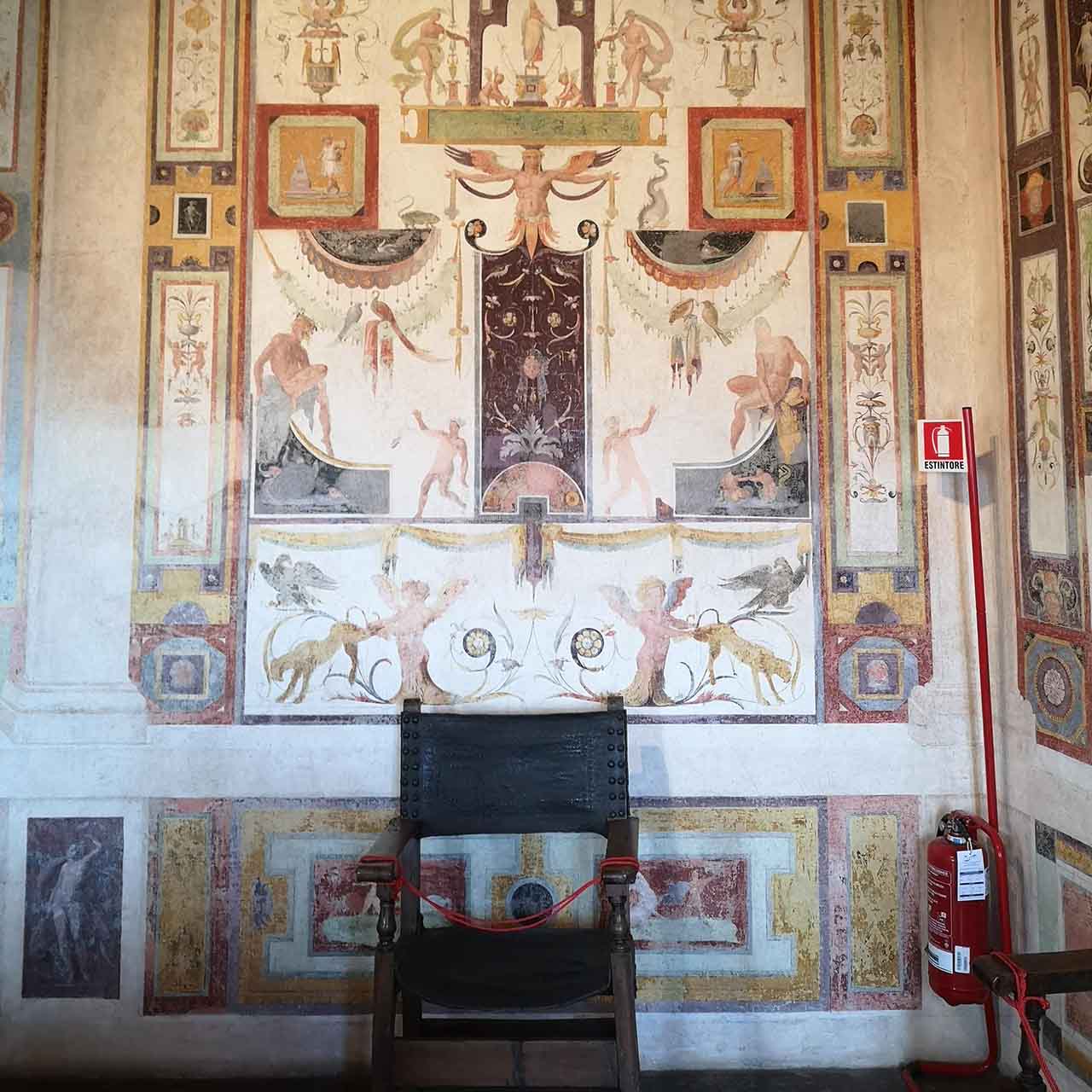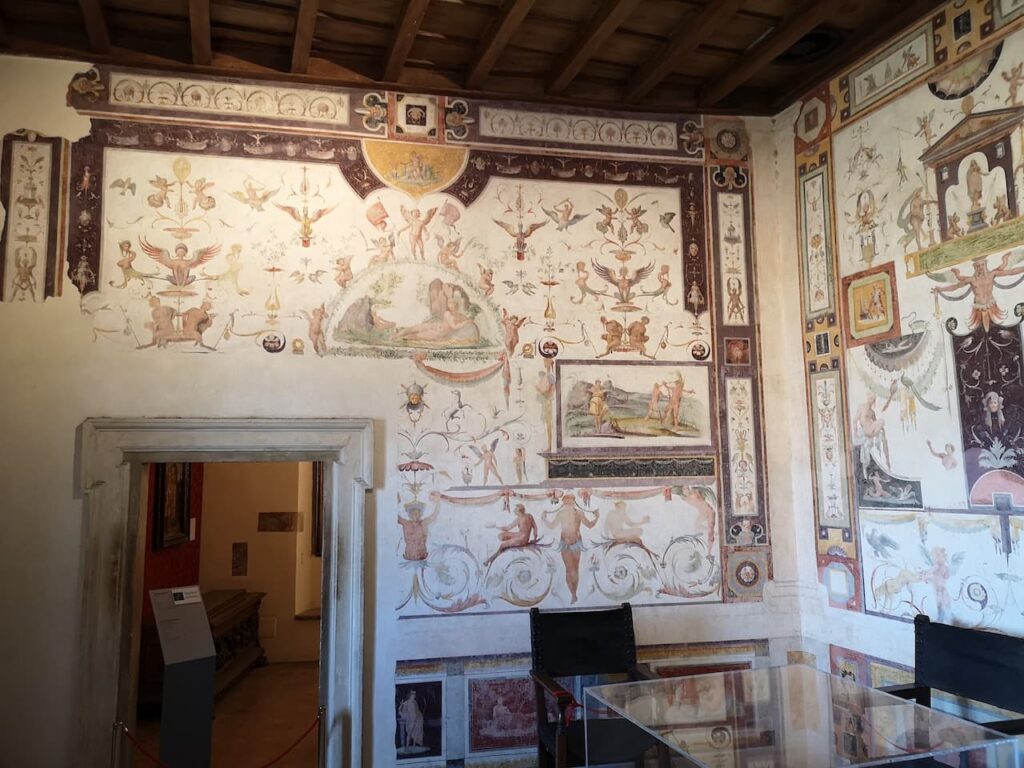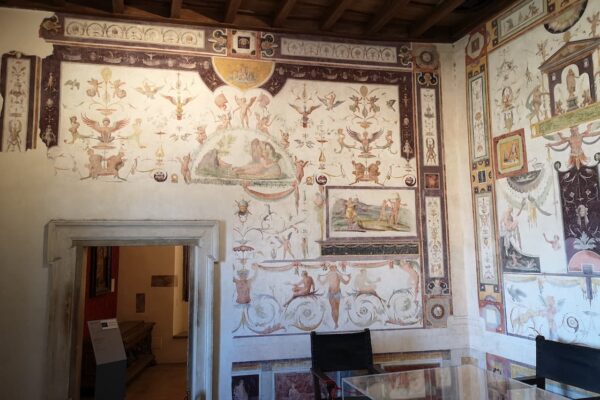Have you heard about the famous Cagliostra di Castel Sant’Angelo in Rome, want to visit it but have no idea how? Don’t worry, you’ve come to the right place!
In this deepening I will tell you the story of the Count of Cagliostro and the luxury cell in Castel Sant’Angelo in which he awaited his sentence.
But that’s not all: the description of this spectacular environment will be followed by useful information on how to visit it, the opening hours and tickets for the National Museum of Castel Sant’Angelo.
Are you ready to learn everything you need for your visit to the castle and the Cagliostra cell? Then let’s get started!
WAIT A MOMENT! Before reading on, a brief warning: always keep in mind that, given the celebrity of this monumental work, to visit the Cagliostra of Castel Sant’Angelo you will certainly run the risk of running into a long queue at the ticket office. To skip the queue, I recommend you buy your ticket directly online. Click below to book your entrance and enter Castel Sant’Angelo in the blink of an eye.

Skip-the-line ticket Castel Sant’Angelo Rome: fast access
Buy online. Choose your preferred time. Visit Rome’s Castel Sant’Angelo, the Sant’Angelo Bridge, the prisons and much more.
You can cancel free of charge up to the day before the visit.
The Cagliostra of Castel Sant’Angelo: History and Description
Contents
Origins
The history of the cell-apartment known as ‘the Cagliostra‘ is inextricably linked to that of its most famous inmate: the Count of Cagliostro.
Giuseppe Balsamo (Cagliostro)was born in Palermo in 1743. His father, a cloth merchant, died shortly after his birth. The child was then taken into a institution for orphans from which, however, he escaped several times.
Transferred in 1756 to the convent of the Fatebenefratelli in Caltagirone, the young man began to take an interest in medicinal herbs and their use.
After returning to his Palermo, the Cagliostro went to Messina, where he met Altotas, his first teacher, with whom he travelled to Egypt, to Rhodes and Malta, and who, in 1766, inducted him into the Order of the Knights of Malta.
In 1768 the Cagliostro was arrested in Rome for a brawl, but was promptly released thanks to the intervention of Cardinal Orsini. In the same year he married Lorenza Feliciani, the illiterate daughter of a bronze smelter.
In Rome, Cagliostro makes a living from his art, namely forging documents with the help of two fellow countrymen: the Marquis Alliata and Ottavio Nicastro, who will eventually denounce him as a forger and force him to flee to Bergamo with his wife and another accomplice. Here the two forgers will again be arrested.
Abroad
Once released, the Cagliostro and Lorenza moved to France. In Aix-en-Provence they met Giacomo Casanova, while from Antibes, thanks to his wife’s illegal gains, they set off in the direction of Barcelona in 1769.
At the end of the same year, they are in Madrid. Maintained by the Marquis of Fontanar, the couple ends up being thrown out of his palace and finds shelter in Lisbon.
The following year they were in London. Here, finding the complicity of his fellow countryman Vivona, Cagliostro organised a scam against a quaker: he had him seduced by his wife Lorenza and then, catching him red-handed, demanded conspicuous compensation for his injured honour. The sum was indeed paid, but Vivona stole it. The Count of Cagliostro, in debt up to his neck, was declared insolvent and arrested.
Released by the intervention of the wealthy Edward Hales, Cagliostro was commissioned to fresco his mansion. The commission, however, did not last long: Cagliostro was thrown out even from here, not only for the mediocrity of his art, but above all for having violated the landlord’s daughter.

In 1772 the Cagliostro and his wife again repaired to France. During the journey they met the lawyer Duplessis, administrator of the estate of the Marchesa de Prie, and thanks to his intervention they found accommodation in the Palace de Prie. Here, Lorenza became the lawyer’s lover; but this time there was no swindle: she in fact left her husband and, to revenge from her years of mistreatment, she denounced him for exploitation of prostitution. Cagliostro responded with a complaint for adultery and abandonment of the marital roof, winning the case. After four months of reclusion, Lorenza retired her charges and returned to her husband in exchange for his release.
The two returned to travel: Belgium, Germany, Malta, Spain and then, in 1776, they were back in London. On this occasion, for the first time, Giuseppe Balsamo assumed the pseudonym of Alessandro, Count of Cagliostro, husband of Serafina, Countess of Cagliostro. The two were initiated into Masonry in 1777.
The following year they were in The Hague, the year after that they migrated to Germany and then to Latvia. Here, posing as a Spanish colonel, Cagliostro gave the impression that he possessed mystical talents.
In St. Petersburg things went wrong: the Count was dismissed by the Spanish ambassador and one of his documents, certifying his membership of the Rosacroces, was recognised as false. During this period, Cagliostro also passed himself off as a taumaturge, avoiding being paid by the poor or in the event of a failure to heal, thus increasing his popularity. Even in this case, however, there was no shortage of denunciations.
In 1780 the couple came to Warsaw, the guest of Adam Poniński, prince, Mason and passionate alchemist. The prince, convinced of the powers of the Count of Cagliostro, joined him with a Masonic brother in the laboratory experiments with which Cagliostro was supposed to transform lead into gold. In 1786, Brother August Fryderyk Moszyński published a booklet with the results of the experiments that clarified Cagliostro’s method: it seems that he obtained gold from lead in a very elementary way, that is, by exchanging the lead container for another that already contained gold.
For this reason, and because of a complaint of molestation during a spiritual session, in 1780 the couple had to repair to France. Here, in Strasbourg, Cagliostro passed himself off as a medic and met the Cardinal de Rohan, who took him to Paris to treat his cousin. Exploiting the cardinal’s influence, the Count sought to have the pope recognise his own ‘Egyptian Rite‘, a Masonic-Religious Order that he himself founded in 1784 after a febrile vision.
In Lyon, after having taken from the other Masonic Lodges twelve “masters” for his order, the Count of Cagliostro built the headquarters of his Lodge. In Paris, the following year, he founded another two Lodges.
It was during this period that he became involved in the scandal of the necklace, a scam against the Cardinal de Rohan perpetrated by two other adventurers, the Countess de la Motte and the Countess De la Motte, who once arrested accused Cagliostro of being the planner of the heist. In 1785, Cagliostro and his wife were arrested and incarcerated in the Bastille. A year later, recognised as innocent, they were released from prison but banished from Paris and France.
The Beginning of The End
They then took refuge in Dover, in England. There, the Count faced a harsh campaign conducted against him by the Courrier de l’Europe, a French government-controlled newspaper, which wrote about his past and discredited him in the eyes of all. The Count tried to defend himself with a letter, but failed. He ended up being isolated.
In 1787 he repaired to Hammersmith. Here he survived by giving lessons in alchemy, but by then everyone knew who he really was: a pupil, during a experiment of Cagliostro’s, substituted the vessel with the metal he was to transmute into gold with another containing tobacco. The transmutation took place anyway, and thus the scam was revealed. At the same time, the Masons of Lyon accused him of spending the Lodge’s money on himself.
Later that year, the Count repaired to Switzerland. His wife, who had remained in England to liquidate his remaining assets, was approached by a journalist from the Courrier de l’Europe and told him of Cagliostro’s mistreatment. When he joined him in Switzerland, he wanted to repudiate publicly, but reconfirmed the accusations in a letter to his parents.
Given the lack of success of his business as a healer, the Count and his wife left first for Aix-les-Bains, then for Turin, Genoa, Venice, Verona, Rovereto and finally reached Trento at the end of 1788. From here, after attempting to obtain a salvation through prince-bishop Pietro Virgilio Thun, they left for Rome, where they stayed with Lorenza’s relatives in Campo de’ Fiori.
Here, Cagliostro was approached by two spies from the Papal States, who asked him to be accepted into Freemasonry. The Count, unaware of the insidiousness, allowed them to perform the initiatory ceremonies.

Skip-the-line ticket Castel Sant’Angelo Rome: fast access
Buy online. Choose your preferred time. Visit Rome’s Castel Sant’Angelo, the Sant’Angelo Bridge, the prisons and much more.
You can cancel free of charge up to the day before the visit.
The Last Arrest
In September of that year (1788) Lorenza denounced her husband. The complaint landed on the desk of the Saint Inquisition. It was soon joined by those of Lorenza’s father and the Vatican spies.
In December of the following year, following a meeting of Pope Pius VI with the Secretary of State and other cardinals, the arrest of Cagliostro and his wife was ordered.
Cagliostro thus ended up in Castel Sant’Angelo on accusations of being a mason, of practising magic, and of blaspheming God. Charges of exploitation of prostitution, fraud, forgery, slander and obscene publications were also added. The defence lawyer attempted to pass off Cagliostro as a charlatan and his wife as an immoral prostitute.
For a year, the Cagliostro waited for his sentence inside the luxury cell that he named after him: the Cagliostra.
La Cagliostra
This environment of Castel Sant’Angelo was built in 1543 together with the Loggia of Paul III below. Initially its archways opened out towards the borgo di Prati, but in the XVIII century they were murdered to convert the room into a prison for prisoners of conscience.

The small apartment is composed of three rooms: one wide and central and two side chambers. From the heraldic emblems of Paul III, depicted in the centre of the vaults, the two small chambers are named Gabinet of the Dolphin and the Salamander and Gabinet of the Stork. The grotesque decoration of the interior walls, in typical Renaissance style, depicts a celebrated landscape and bears the signatures of the illustrious painters Luzio Luzi and Perin del Vaga.
The End of Count Cagliostro
Lorenza was released, while the Cagliostro was spared the death sentence and turned into ergastolo. After abbey, in 1791 the Count was transferred to the Rocca di San Leo, in the Tuscan-Romagna Apennines. There he repented and spent his years of imprisonment painter and drawing religious scenes. In 1793 he wrote a letter to the pope trying, unsuccessfully, to convince him of his repentance. In August 1795 the Count was found semiparalised in his cell. For three days he remained in that state, rejecting the confession and penances. He died and was buried as an infidel, without coffin or headstone, near the fortress. A witness of the time recounted this anecdote: a few years after the Count’s death, Polish troops, allied with the French, arrived and occupied the fort giving freedom to the convicts who, with the help of soldiers, dug up the Count’s pits and used his skull as a cup in which to consume alcohol.
Cagliostra Prison: How To Visit It

To visit the famous cella known as ‘la Cagliostra’ you must first get to Castel Sant’Angelo.
You can choose to do so by bus (lines 23, 115, 271, 280, 62, 982, 40, 34, 49, 190F), by metro (Lepanto and Ottaviano stations), by train (Rome San Pietro station), by car or on foot.
Once inside the museum, the most direct route to reach the Cagliostra is as follows:
- from the outer courtyard enter the Dromos and then the Atrium, walk along the helical ramp and the diameter ramp, passing the Urna Room;
- when you reach the Cortile dell’Angelo, take the stairs in front at the exit; then walk along the Loggia di Giulio II, enter the Sala Paolina and enter the Corridoio Pompeiano;
- Once you arrive in the Library Room you will find the entrance to the Cagliostra luxury prison on your right.
The visiting hours are naturally linked to the opening hours of the National Museum of Castel Sant’Angelo, i.e. Tuesday to Sunday, from 9.00 to 19.30 with last admission at 18.00.
What are you waiting for? Are you ready to visit the famous Cagliostra too? Read on for the best tickets to visit.
Cagliostra Mole Adriana: Tickets
Unlike other areas of Castel Sant’Angelo, the Cagliostra can also be visited without the accompaniment of an official guide;
However, it is possible – and in many ways advisable – to book an audioguide or guided tour of the castle;
Below I leave you our selection of the best tickets you can buy online. I’m sure you’ll find one that suits you!

Skip-the-line ticket Castel Sant’Angelo Rome: fast access
Buy online. Choose your preferred time. Visit Rome’s Castel Sant’Angelo, the Sant’Angelo Bridge, the prisons and much more.
You can cancel free of charge up to the day before the visit.
Cagliostra Rome: Frequently Asked Questions
Giuseppe Balsamo, better known as the Count of Cagliostro, was an Italian adventurer, alchemist and esotericist who lived in the Eighteenth Century.
After living wandering through the courts of half of Europe, he was convicted by the Saint Inquisition to ergastolo for numerous offences, the most serious of which was heresy.
Jailed for about a year inside the famous Cagliostra (after which he was named) he was transferred to the Rocca di San Leo, where he died.
Arrested and convicted and sentenced to life imprisonment, in 1791 the Count absconded and was transferred to the Rocca di San Leo, in the Tuscan-Romagna Apennines.
Here he repented and spent his years of imprisonment pregnating and drawing religious scenes. In 1793 he wrote to the pope trying, unsuccessfully, to convince him of his own repentance.
In August 1795 he was found semiparalised in his cell. For three days he remained in that state, rejecting confession and penitence. He died and was buried as an infidel, without coffin or tombstone.
The Count of Cagliostro was buried without a Christian rite near the Stronghold of San Leo, where he died. However, a witness of the time says that, a few years later, the Polish troops, allied with the French, arrived and occupied the fortress, giving freedom to the convicts who, with the help of the soldiers, leaked the Count’s grave and used his skull as a cup in which to consume alcohol.
On 26 August 1795 the adventurer, alchemist and esotericist Giuseppe Balsamo, better known as Conte di Cagliostro, died in his cell in the Rocca di San Leo, where he had been condemned to spend his life following accusations of heresy by the Holy Inquisition.
Prison of Cagliostro: Conclusions

And here we are at the end of this in-depth study on the Cagliostra of Castel Sant’Angelo.
In this article, I told you the story of the famous adventurer, the Count of Cagliostro, and of the cell in Castel Sant’Angelo in which he waited for his sentence;
I have also given you all the information you need to get to this area of the castle and the entrance tickets you can buy to visit it;
To finish, I answered the most frequently asked questions about the Cagliostra and the Count of Cagliostro.
If you need more information, please leave a comment below; if you would like to visit the Castle and the Cagliostra, purchase your ticket and skip the queue at the ticket office.


